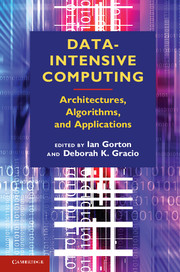Book contents
- Frontmatter
- Contents
- List of Contributors
- 1 Data-Intensive Computing: A Challenge for the 21st Century
- 2 Anatomy of Data-Intensive Computing Applications
- 3 Hardware Architectures for Data-Intensive Computing Problems: A Case Study for String Matching
- 4 Data Management Architectures
- 5 Large-Scale Data Management Techniques in Cloud Computing Platforms
- 6 Dimension Reduction for Streaming Data
- 7 Binary Classification with Support Vector Machines
- 8 Beyond MapReduce: New Requirements for Scalable Data Processing
- 9 Let the Data Do the Talking: Hypothesis Discovery from Large-Scale Data Sets in Real Time
- 10 Data-Intensive Visual Analysis for Cyber-Security
- Index
- References
4 - Data Management Architectures
Published online by Cambridge University Press: 05 December 2012
- Frontmatter
- Contents
- List of Contributors
- 1 Data-Intensive Computing: A Challenge for the 21st Century
- 2 Anatomy of Data-Intensive Computing Applications
- 3 Hardware Architectures for Data-Intensive Computing Problems: A Case Study for String Matching
- 4 Data Management Architectures
- 5 Large-Scale Data Management Techniques in Cloud Computing Platforms
- 6 Dimension Reduction for Streaming Data
- 7 Binary Classification with Support Vector Machines
- 8 Beyond MapReduce: New Requirements for Scalable Data Processing
- 9 Let the Data Do the Talking: Hypothesis Discovery from Large-Scale Data Sets in Real Time
- 10 Data-Intensive Visual Analysis for Cyber-Security
- Index
- References
Summary
Data management is the organization of information to support efficient access and analysis. For data-intensive computing applications, the speed at which relevant data can be accessed is a limiting factor in terms of the size and complexity of computation that can be performed. Data access speed is impacted by the size of the relevant subset of the data, the complexity of the query used to define it, and the layout of the data relative to the query. As the underlying data sets become increasingly complex, the questions asked of it become more involved as well. For example, geospatial data associated with a city is no longer limited to the map data representing its streets, but now also includes layers identifying utility lines, key points, locations, and types of businesseswithin the city limits, tax information for each land parcel, satellite imagery, and possibly even street-level views. As a result, queries have gone from simple questions, such as, “How long is Main Street?,” to much more complex questions such as, “Taking all other factors into consideration, are the property values of houses near parks higher than those under power lines, and if so, by what percentage?” Answering these questions requires a coherent infrastructure, integrating the relevant data into a format optimized for the questions being asked.
Data management is critical to supporting analysis because, for large data sets, reading the entire collection is simply not feasible. Instead, the relevant subset of the data must be efficiently described, identified, and retrieved. As a result, the data management approach taken effectively defines the analysis that can be efficiently performed over the data.
- Type
- Chapter
- Information
- Data-Intensive ComputingArchitectures, Algorithms, and Applications, pp. 48 - 84Publisher: Cambridge University PressPrint publication year: 2012



